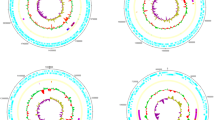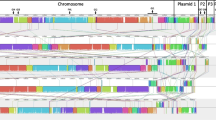Abstract
Plant growth-promoting bacteria of the genus Azospirillum are present in the rhizosphere and as endophytes of many crops. In this research we studied 40 Azospirillum strains isolated from different plants and geographic regions. They were first characterized by 16S rDNA restriction analysis, and their phylogenetic position was established by sequencing the genes 16S rDNA, ipdC, hisC1, and hisC2. The latter three genes are involved in the indole-3-pyruvic acid (IPyA) biosynthesis pathway of indole-3-acetic acid (IAA). Furthermore, the suitability of the 16S-23S rDNA intergenic spacer sequence (IGS) for the differentiation of closely related Azospirillum taxa and development of PCR protocols allows for specific detection of strains. The IGS-RFLP analysis enabled intraspecies differentiation, particularly of Azospirillum brasilense and Azospirillum lipoferum strains. Results demonstrated that the ipdC, hisC1, and hisC2 genes are highly conserved in all the assessed A. brasilense isolates, suggesting that these genes can be used as an alternative phylogenetic marker. In addition, IAA production determined by HPLC ranged from 0.17 to 98.2 μg mg−1 protein. Southern hybridization with the A. brasilense ipdC gene probe did not show, a hybridization signal with A. lipoferum, Azospirillum amazonense, Azospirillum halopreferans and Azospirillum irakense genomic DNA. This suggests that these species produce IAA by other pathways. Because IAA is mainly synthesized via the IPyA pathway in A. brasilense strains, a species that is used worldwide in agriculture, the identification of ipdC, hisC1, and hisC2 genes by PCR may be suitable for selecting exploitable strains.






Similar content being viewed by others
References
Altschul SF, Madden TL, Schaffer AA et al (1997) Gapped BLAST and PSI-BLAST: a new generation of protein database search programs. Nucleic Acids Res 25:3389–3402. doi:10.1093/nar/25.17.3389
Ausubel F, Brent R, Kingston RE et al (1995) Short protocols in molecular biology. Wiley, New York
Baca BE, Elmerich C (2007) Microbial production of plants hormones by microorganisms. In: Elmerich C, Newton WE (eds) Associative nitrogen-fixation bacteria and cyanobacteria. IV Series: nitrogen fixation: origins, applications, and research progress. Springer Life Science, Dordrecht
Baldani JI, Sampaio Videira S, dos Santos Teixeira KR, Massena Reis V, Martinez de Oliveira AL, Schwab S, Maltempi de Souza E, Pedraza RO, Baldani VLD, Hartmann A (2014) The family rhodospirillaceae. In: Rosenberg E et al (eds) The prokaryotes—alphaproteobacteria and betaproteobacteria. Springer, Berlin. doi:10.1007/978-3-642-30197-1_300
Bashan Y, de Bashan LE (2010) How plant growth-promoting bacterium Azospirillum promotes plant growth—a critical assessment. In: Spark D (ed) Advances in agronomy, vol 108. Academic Press, Burlington, pp 77–136
Bashan Y, de Bashan LE, Prabhu R, Hernandez JP (2014) Advances in plant growth-promoting bacterial inoculant technology: formulations and practical perspectives. Plant Soil 378:1–33. doi:10.1007/s11104-013-1956
Baudoin E, Couillerot O, Spaepen S, Moënne-Loccoz Y, Nazaret S (2010) Applicability of 16S-23S rDNA internal spacer for PCR detection of the phytostimulatory PGPR inoculant Azospirillum lipoferum CRT1 in field soil. J Appl Microbiol 108:25–38
Carreño-López R, Campos-Reales NB, Elmerich C, Baca BE (2000) Physiological evidence for differently regulated tryptophan-dependent pathways for indole-3-acetic acid synthesis in Azospirillum brasilense Sp7. Mol Gen Genet 264:521–530
Castro-Guerrero J, Romero-Osorio A, Aguilar-Piedras JJ, Xiqui-Vázquez ML, Sandoval-Romero JO, Baca BE (2012) The gene hisC1 of Azospirillum brasilense Sp7, encoding the aromatic amino acid aminotransferase-1, is expressed in wheat. Plant Soil 356:139–150
Creus CM, Sueldo RJ, Barassi CA (2004) Water relations and yield in Azospirillum—inoculated wheat exposed to drought in the field. Can J Bot 82:273–281
Di Salvo LP, Carlino ME, Cellucci GC, García de Salamone IE (2012) Azospirillum brasilense y fertilización nitrogenada: incremento sustentable del rendimiento de maíz. In: XIX Congreso Latinoamericano de la Ciencia del Suelo. XXIII Congreso Argentino de la Ciencia del Suelo. ISBN 978-987-1829-11-8. http://www.academia.edu/4241273/AZOSPIRILLUM
Di Salvo L, Silva E, Teixeira KRS, Esquivel-Cote R, Pereyra MA, García de Salamone I (2014) Physiological and biochemical characterization of Azospirillum brasilense strains commonly used as plant growth-promoting rhizobacteria. J Basic Microbiol 54:1–12
Díaz-Zorita M, Fernández-Canigia M (2009) Field performance of a liquid formulation of Azospirillum brasilense on dryland wheat productivity. Eur J Soil Biol 45:3–11
Dobbelaere S, Croonenborghs A, Thys A, Ptacek D et al (2001) Response of agronomically important crops to inoculation with Azospirillum. Aust J Plant Physiol 28:871–879
Doty SL, Dosher MR, Singleton GL (2005) Identification of an endophytic rhizobium in stems of Populus. Symbiosis 39:27–35
Garcia de Salamone IE, Döbereiner J, Urquiaga S, Boddey RM (1996) Biological nitrogen fixation in Azospirillum strain-maize genotype associations as evaluated by the a 15N isotope dilution technique. Biol Fertil Soils 23:249–256
García-Martínez J, Acinas SG, Antón AI, Rodríguez-Valera F (1999) Use of the 16S-23S ribosomal genes spacer region in studies of prokaryotic diversity. J Microbial Methods 36:55–64
Hartmann A, Rothballer M, Schmid M (2008) Lorenz Hiltner, a pioneer in rhizosphere microbial ecology and soil bacteriology research. Plant Soil 312:7–14
Jensen RA, Gu W (1996) Evolutionary recruitment of biochemical specialized subdivisions of family I within the protein superfamily of aminotransferases. J Bacteriol 178:2161–2171
Kaneko T, Minamisawa K, Isawa T, Nakatsukasa H et al (2010) Complete genomic structure of the cultivated rice endophyte Azospirillum sp. B510. DNA Res. doi:10.1093/dnares/dsp026
Khammas KM, Ageron E, Grimont PAD, Kaiser P (1989) Azospirillum irakense sp. nov., a nitrogen-fixing bacterium associated with rice roots and rhizosphere soil. Rev Microbiol 140:679–693
Lerner A, Valverde A, Castro-Sowinski S, Lerner H, Okon Y, Burman S (2010) Phenotypic variation in Azospirillum exposed to starvation. Environ Microbiol Rep 2:577-586
Lin SY, Shen FT, Young CC (2011) Rapid detection and identification of the free-living nitrogen-fixing genus Azospirillum by 16SrRNA-gene-targeted genus-specific primers. Antonie van Leeuwenhoek J 99:837–844
Lugtenberg BJJ, Malfanova N, Kamilova F, Berg G (2013) Plant growth promotion by microbes. In: de Bruijin FJ (ed) Molecular microbial ecology of the rhizosphere, vol 2. Wiley, Hoboken, pp 561–573
Magalhães FMM, Baldani JI, Souto SM, Kuykendall JR, Döbereiner J (1983) A new acid tolerant Azospirillum species. Ann Acad Bras Cienc 55:417–430
Malhotra M, Srivatava S (2008a) An ipdC gene knout-out of Azospirillum strain SM and its implications on the indole-3-acetic acid biosynthesis and plant growth promotion. Antonie van Leeuwenhoek J 3:425–433
Malhotra M, Srivatava S (2008b) Organization of the ipdC region regulates IAA levels in different Azospirillum brasilense strains: molecular and functional analysis of ipdC in strain SM. Environ Microbiol 10:1365–1373
Mascarua-Esparza MA, Villa-González R, Caballero-Mellado J (1988) Acetylene reduction and indoleacetic acid production by Azospirillum isolates from Cactaceous plants. Plant Soil 106:91–95
Pedraza RO, Ramírez-Mata A, Xiqui-Vázquez MA, Baca BE (2004) Aromatic amino acid amino transferase activity and indole-3-acetic acid production by associative nitrogen-fixing bacteria. FEMS Microbiol Lett 233:15–21
Pedraza RO, Motok J, Tortora ML, Salazar SM, Díaz-Ricci JC (2007) Natural occurrence of Azospirirllum brasilense in strawberry plants. Plant Soil 295:169–178
Pérez-García O, Escalante FME, de Bashan LE, Bashan Y (2011) Heterotrophic cultures of microalgae: metabolism and potential products. Water Res 45:11–36
Rariz G, Martínez A, Ferrando L, Menes RJ, Fernéndez-Scavino A (2013) Characterization and interactions between rice-associated bacteria with plant-growth promoting properties. Rev Agron N O Argent 33:13–24
Reinhold B, Hurek T, Fendrik I, Pot B, Gillis M, Kersters K, Thielemans S, De Ley J (1987) Azospirillum halopraeferens sp. nov., a nitrogen-fixing organism associated with roots of Kallar grass (Leptochloa fusca (L.) Kunth). Int J Syst Bacteriol 37:43–51
Rothballer M, Schmid M, Fekete A, Hartmann A (2005) Comparative in situ analysis of ipdC-gfpmut3 promoter fusions of Azospirillum brasilense strains Sp7 and Sp245. Environ Microbiol 7:1839–1846
Sant’Anna FH, Almeida LGP, Cecagno R, Reolon LA et al (2011) Genomic insights into the versatility of the plant growth-promoting bacterium Azospirillum amazonense. BMC Genomics 12:409. doi:10.1186/1471-2164-12-409
Sivaraman J, Li Y, Larocque R, Chrag J, Cygler M, Matte A (2001) Crystal structures of histidinol phosphate amino transferase (HisC) from Escherichia coli, and its covalent complex with pyridoxal phosphate-5′-phosphate. J Mol Biol 311:761–776
Soto-Urzúa L, Xochihua-Corona YG, Flores-Encarnación M, Baca BE (1996) Purification and properties of aromatic amino acid aminotransferase from Azospirillum brasilense UAP 14 strain. Can J Microbiol 42:294–298
Spaepen S, Vanderleyden J, Remans R (2007a) Indole-3-acetic acid in microbial and microorganism-plant signaling. FEMS Microbiol Rev 31:425–438
Spaepen S, Versées W, Gocke D, Pohl M, Steyaert J, Vanderleyden J (2007b) Characterization of phenylpyruvate decarboxylase, involved in auxin production of Azospirillum brasilense. J Bacteriol 180:7626–7763
Szkop M, Bielaswki W (2013) A simple method for simultaneous RP-HPLC determination of indolic compounds related to bacterial biosynthesis of indole-3-acetic acid. Antonie van Leeuwenhoek J 103:683–691
Tamura K, Peterson D, Peterson N, Stecher G, Nei M, Kumar S (2011) MEGA5: molecular evolutionary genetics analysis using maximum likelihood, evolutionary parsimony methods. Mol Biol Evol. doi:10.1093/molbev/msr121
Tarrand JJ, Krieg NR, Döbereiner J (1978) A taxonomic study of the Spirillum lipoferum group, with descriptions of a new genus, Azospirillum gen. nov. and two species, Azospirillum lipoferum (Beijerinck) comb. nov. and Azospirillum brasilense sp. nov. Can J Microbiol 24:967–980
Vande Broek A, Gysegom P, Ona O, Hendrickx N, Prinsen E, Van Impe J, Vanderleyden J (2005) Transcriptional analysis of the Azospirillum brasilense indole-3-pyruvate decarboxylase gene and identification of a cis-acting sequence involved in auxin responsive expression. Mol Plant Microbe Interact 18:311–323
Venieraki A, Dimou M, Pergalis P, Kefalogianni I, Chatzipavlidis I, Katinakis P (2011) The genetic diversity of culturable nitrogen-fixing bacteria in the rhizosphere of wheat. Microbial Ecol 61:277–285. doi:10.1007/s00248-010-9747-1-9
Vezyri E, Venieraki A, Dimou M, Chatzipavlidis I, Tampakaki A, Katinakis P (2013) Phylogenetic analysis of Azospirillum species isolated from the rhizosphere of field-grown wheat based on genetic and phenotypic features. In: de Bruijin FJ (ed) Molecular microbial ecology of the rhizosphere, vol 1. Wiley, Hoboken
Vial L, Lavire C, Mavingui P, Blaha D, Haurat J, Moenne-Loccoz Y, Bally R, Wisniewski-Dye F (2006) Phase variation and genomic architecture changes in Azospirillum. J Bacteriol 188:5364–5373
Vinuesa P, Radamarker JLW, de Bruijn FJ, Werner D (1998) Genotypic characterization of Bradyrhizobium strains nodulating endemic woody legumes of the Canary Islands by PCR-restriction fragment length polymorphism analysis of genes encoding 16S rRNA (16S rDNA) and 16S-23S rDNA intergenic spacers, repetitive extragenic palindromic PCR genomic fingerprinting, and partial 16S rDNA Sequencing. Appl Environ Microbiol 64:2096–2104
Wisniewski-Dye F, Borziak K, Khalsa-Moyers G, Alexandre G, Sukharnikov LO et al (2011) Azospirillum Genomes reveal transition of bacteria from aquatic to terrestrial environments. PLoS Genet 7:e1002430. doi:10.1371/journal.pgen.1002430
Acknowledgments
We are grateful to Dr. C. Elmerich to the gift of Pseudomonas stutzeri A1501 strain, Noé Arroyo for technical assistance, and Ira Fogel for English editing. This work was supported by the Consejo Nacional de Ciencia y Tecnología) to B.E.B (CONACyT grant 49227-Z) and funding by a collaborative grant to B.E.B., R.P., I. G de S. and A.F.S. from Ciencia y Tecnología para el Desarrollo (CYTED). S. J. M., C. M. J. and L.S.U. are recipients CONACYT fellowships, respectively. Authors appreciate to Editor and Reviewers for constructive and valuable comments.
Author information
Authors and Affiliations
Corresponding author
Electronic supplementary material
Below is the link to the electronic supplementary material.
Rights and permissions
About this article
Cite this article
Jijón-Moreno, S., Marcos-Jiménez, C., Pedraza, R.O. et al. The ipdC, hisC1 and hisC2 genes involved in indole-3-acetic production used as alternative phylogenetic markers in Azospirillum brasilense . Antonie van Leeuwenhoek 107, 1501–1517 (2015). https://doi.org/10.1007/s10482-015-0444-0
Received:
Accepted:
Published:
Issue Date:
DOI: https://doi.org/10.1007/s10482-015-0444-0




